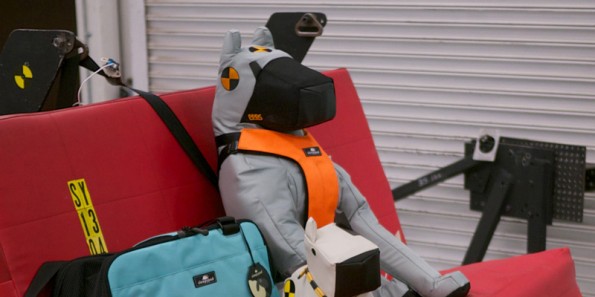Most of us wouldn’t consider going for a drive without buckling up and would likely insist the other passengers in our car do so as well. So, doesn’t it seem like a logical extension to buckle up our pets when they are in the car with us too?
This issue came to the forefront the other day when I saw a sweet little Bichon Frise with a sore neck. The dog travels by car daily with his owner. On the way home from work, the owner was forced to stop the car suddenly and the dog fell forward, off the passenger seat and landed awkwardly on the floor of the car.
Luckily this dog’s injury was mild and his sore neck improved with rest and pain medication. For future car rides the owner wanted to know my opinion on how to keep the dog safe from injury.
For those with SUV’s or wagons, keeping your pet in the cargo prevents them from being a dangerous distraction while you drive. By putting up a barrier between the cargo area and passenger area you have the added benefit of preventing your pet from being thrown into the passenger area and becoming a deadly projectile to the passengers during an accident. However, your pet can still be thrown about and even ejected out of the vehicle, resulting in serious injury to your pet. The same essentially is true for keeping your pet in a carrier or crate during a car ride. For a cat there really is no better option at this time. My recommendation is to ensure that the crate is at least well situated in the car so that it doesn’t slide about during regular car movement.
For dogs we have the option of using a car safety restraint. This seems instinctively the best option for keeping your dog safely restrained in the vehicle. What surprised me during this research is currently there are no performance standards or test protocols in the US for pet travel products. What this means is that although manufacturers may claim to test their products, without test standards, these claims cannot be substantiated.
In 2013, Subaru of America and the Centre for Pet Safety, a registered non-profit research and advocacy organization dedicated to companion animal and consumer safety, announced they would create standards for testing restraints and tested many of the popular restraints on the market based on the standard currently used to certify child safety seats.
Each harness was first subjected to a preliminary strength test; if the harness remained intact during the strength test, it would continue onto the crash test portion of the evaluation where a ‘crash test dog’ and restraining device would be put through various crash situations.
Here are the results:
Sleepypod Clickit Utility was the only harness tested where the dogs remained restrained during every test.
Kelin Metal AllSAfe, Cover Craft RuffRider Roadie, RC Pet Canine Friendly Crash Tested, Bergan Dog Auto Harness, Kurgo Tru-Fit Enhanced Strength and IMMI PetBuckle did not perform as well. Some of the harnesses allowed the dog to launch off of the seat; others did not control the rotation of the dog and the worst products such as the Kurgo and IMMI, were deemed catastrophic failures as they allowed the dog to become projectile or be released from the restraint.
We want to keep our best friends as safe on the road as possible. Use a crate in the back seat for your cat and a Sleepypod Clickit harness for your dog.
Dr. Loretta Yuen D.V.M


